Nihondaira & Kunozan Toshogu Shrine 日本平・久能山東照宮
|
Title   • File Name • File Name   • Date • Date   • Position • Position   |
|

From Shizuoka Station (bus stop 19), it takes 35 min. by bus to Nihondaira. The bus comes to this Nihondaira Park Center. From here, you can easily walk to the points of interest.
|
|

Nihondaira is a plateau 308 meters high. It affords great views almost all around. There are a few lookout points on Nihondaira and this is one of them on Nihondaira's peak. Called Ginbodai.
|
|

Monument on the peak of Nihondaira. It says "Ginbodai." 吟望台
|
|

One main attraction of Nihondaira is views of Mt. Fuji and Miho no Matsubara on sunny days. If it's really sunny, you can also see the Izu Peninsula.
|
|

Mt. Fuji as seen from Nihondaira's Ginbodai. Even sunny days can be hazy, but at least Mt. Fuji was visible when I went in mid-March. It was too hazy to see the Izu Peninsula.
|
|

Mt. Fuji as seen from Nihondaira.
|
|
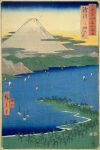
Hiroshige's woodblock print of Miho no Matsubara Beach and Mt. Fuji from his "Famous Views of the 60 Provinces" series.
|
|

Off of Shimizu Port is Miho no Matsubara, a pine-clad, slither of land jutting into the ocean.
|
|
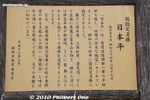
Nihondaira was designated as a National Scenic Site in 1963 by the Japanese government. This high and flat plateau was recognized for its grand views all around, especially of Mt. Fuji. It also includes Mt. Kunozan, home of Toshogu Shrine.
|
|

Nihondaira marker
|
|

Statue of a mother and child. Based on the famous children's song called "Akai Kutsu" (Red Shoes). The song was modeled after a little girl who was from Shimizu, Shizuoka. The sculpture was made in 1986.
|
|
|
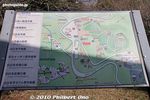
Map of Nihondaira. It's not as spread out as it looks. Everything is within easy walking distance. If you visit in Feb., see the ume plum trees in bloom.
|
|

Another lookout deck is this Higashi Tenbodai or Eastern Lookout Deck. 東展望台
|
|

View from the Eastern Lookout Deck on Nihondaira.
|
|

Mt. Fuji as seen from the Eastern Lookout Deck. This is one place where you would want to visit on a clear day. Otherwise, you won't see Mt. Fuji.
|
|

Shimizu Port and Miho no Matsubara beyond it. Miho Peninsula is also home of one of Japan's swan maiden legends. There's even a shrine dedicated to the swan maiden.
|
|
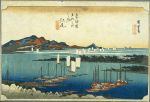
Hiroshige's woodblock print of Ejiri (19th post town on the Tokaido) from his "Fifty-Three Stations of the Tokaido Road" series. Miho no Matsubara in the background.
|
|

Nihondaira monument in the parking lot.
|
|

Nihondaira monument and Mt. Fuji.
|
|

Tea Hall (Cha Kaikan) 茶会館
|
|

Not much inside the Tea Hall which sells some tea.
|
|

Yet another Nihondaira stone marker.
|
|

Another lookout deck on top of a souvenir shop. Free admission. Go up to the 4th floor.
|
|

View of Nihondaira's parking lot and Mt. Fuji.
|
|
|

View of Mt. Fuji from Nihondaira
|
|
|

Shizuoka city
|
|

Lots of antenna atop Nihondaira.
|
|
|

Nihondaira ume plum grove. Flowers already withered by the time I was there in mid-March. 日本平梅園
|
|

But I did find a plum tree with flowers. Smells nice.
|
|

I went on a Sunday and it was noisy with all these motorcycles and sports cars buzzing around. They catch their thrills on the curving roads of Nihondaira.
|
|

Back at the Nihondaira Park Center (next to the bus stop), there are souvenir shops and a ropeway station to go to Kunozan Toshogu Shrine.
|
|

There's also a lookout deck on the roof of the Nihondaira Park Center.
|
|

View of central Shizuoka city from Nihondaira Park Center.
|
|

Song monument
|
|

Kunozan in the distance. You can see Kunozan's sloping peak on which Kunozan Toshogu Shrine is built. Its elevation is 270 meters.
|
|

Kunozan is accessible by ropeway (aerial tram) from Nihondaira or by winding steps going up on the other side from the coastal road.
|
|

Lover's Monument near the Nihondaira ropeway.
|
|

Lock your heart.
|
|

By coincidence, a newly married couple disembarked from the ropeway after their wedding held at Kunozan Toshogu Shrine. We clapped for them.
|
|

Nihondaira Ropeway costs 550 yen one way (1000 yen round trip). If you go to Nihondaira by bus, you can take a bus back from Kunozan instead of going back to the Nihondaira bus stop.
|
|

Nihondaira Ropeway operates from 9:10 am to 5:15 pm (till 4:15 pm in winter months).
|
|
|

Riding the Nihondaira Ropeway to Kunozan. Built in 1957, the ropeway is 1,065 meters long.
|
|

Nihondaira Ropeway to Kunozan. The ropeway ride is only only 5 min. It runs quite often.
|
|

The Nihondaira Ropeway goes over Byobu-dani Valley, noted for rock formations resembling folding screens (byobu).
|
|

Kunozan is right next to the coast. That's the Pacific Ocean.
|
|
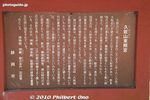
About Kunozan Toshogu Shrine in Japanese.
|
|

About Kunozan Toshogu Shrine in English.
|
|
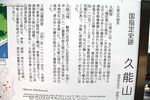
Mt. Kunozan probably got its name from Kunoji temple built by Kuno Tadahito in 600. The temple suffered a fire in 1225. In 1568, Takeda Shingen moved the temple to Shimizu and built a castle on Kunozan.
|
|
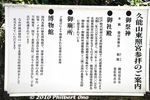
In 1582, the Takeda clan was defeated and Kunozan fell to the Tokugawa. Kunozan Toshogu Shrine was built in 1617 by Tokugawa Hidetada to bury and deify his father Tokugawa Ieyasu.
|
|
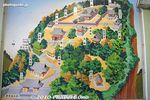
Map of Kunozan Toshogu Shrine. It's not as big as it looks. The shrine is one of Nihondaira's main attractions. It was the original burial site of Shogun Tokugawa Ieyasu. The shrine was built by his son Hidetada.
|
|

Kunozan Toshogu Shrine was built 19 years before the famous Nikko Toshogu Shrine (Tochigi Prefecture) which is where Ieyasu was reburied. According to his will, Ieyasu wanted to be buried on Kunozan. Before the shrine, there was a temple and a castle here
|
|

Admission to Kunozan Toshogu Shrine is 500 yen (or 800 yen if you also want to see the museum). It's worth it. After paying admission, you see this Romon Gate which is an Important Cultural Property. 楼門
|
|

Carving on Romon Gate. If you've been to Nikko Toshogu Shrine, many architectural and artistic elements here at Kunozan will look familiar.
|
|

Handprint of Tokugawa Ieyasu displayed behind Romon Gate.
|
|

Torii
|
|

Ieyasu plum tree
|
|

Sacred horse stable. (Mannequin horse)
|
|

Purification water fountain is an Important Cultural Property.
|
|

Site of a five-story pagoda which had to be torn down in 1873 when Shinto shrines and Buddhist temples had to be separated. (A pagoda is a Buddhist structure.)
|
|
|
|
|

Kunozan Toshogu is designated as an Important Cultural Property, but unlike the Nikko Toshogu, there are no National Treasures (except in the museum).
|
|

Karamon Gate entrance to the Haiden Hall. The ornate Karamon Gate is an Important Cultural Property. However, we are not allowed to enter through this gate. 拝殿
|
|

Karamon Gate's ornate roof.
|
|
|

Kaguraden Hall for sacred dances is also an Important Cultural Property. 神楽殿
|
|

Roof tiles are decorated with the Tokugawa crest.
|
|
|
|

Hieda Shrine is what you see before the Honden main hall.
|
|

Tokugawa crest on this rain catcher.
|
|

Side gate to the Haiden and Honden Halls.
|
|

Side gate roof.
|
|

Honden roof
|
|

Side gate to Honden
|
|

Side gate
|
|

Side gate roof
|
|

Tokugawa crest
|
|

Honden Hall of Kunozan Toshogu Shrine at Nihondaira, Shizuoka. The shrine's focal point and most magnificent building. Important Cultural Property.
|
|

They repaint and lacquer the shrine only once every 50 years. It takes several years to complete the job and they just finished it in 2006.
|
|

The shrine looks spanking new and the colors are very impressive. It cost 1,300,000,000 yen to restore the lacquer and paint.
|
|

Lion dog painting on the Hionden Hall.
|
|

Honden Hall roof
|
|

Roof corner
|
|
|
|
|
|
|

Carving
|
|
|
|
|
|
|
|
|
|
|
|

Honden Hall
|
|
|
|
|
|

It takes about 30 processes to restore the lacquer.
|
|

Plexiglass protects the lower carvings.
|
|

Karamon Gate door carving
|
|

View from Karamon Gate
|
|

Honden Hall
|
|
|
|
|
|

Gate to Tokugawa Ieyasu's tomb is also an Important Cultural Property. 廟所
|
|
|
|

Approach to Ieyasu's tomb
|
|

Tokugawa Ieyasu's tomb at Kunozan Toshogu
|
|

Tokugawa Ieyasu's tomb at Kunozan Toshogu. The tomb actually faces west, toward Okazaki in Aichi Prefecture where Ieyasu was born. 神廟
|
|
|

Tokugawa Ieyasu's tomb at Kunozan Toshogu
|
|
|
|
|

Kunozan Toshogu Shrine Museum has about 2,000 pieces in its collection of mostly everyday things used by Ieyasu and other Tokugawa shoguns. Besides swords, there are Western articles. 博物館
|
|

Inside Kunozan Toshogu Shrine Museum, articles belonging to Ieyasu are displayed. If you're Spanish, you'd be interested in seeing the Spanish clock owned by Ieyasu. Admission charged.
|
|
|
|

Lookout deck
|
|

View from lookout deck
|
|
|
|

Gate keeper station 門衛所
|
|

Stone steps going down to the coast. It takes about 20 min. to go down these stone steps to the bottom. There are 1,159 stone steps which don't mean much unless you're climbing up.
|
|

It might take at least 30 min. to go up these steps, 1,159 steps spanning 760 meters with 17 switchbacks.
|
|

Nice view from the stone steps. Those vinyl houses are growing strawberries which are sold everywhere at the foot of Kunozan during Jan. to May.
|
|

Stone steps 石段
|
|

Plum garden marker
|
|

Plum garden marker
|
|

Plum trees
|
|
|
|
|

Stone torii 山下石鳥居
|
|

Torii with Kunozan in the background.
|
|

Parking area for people going to Nihondaira via the steps up the mountain. Near here is the bus stop for Shizuoka Station.
|
|
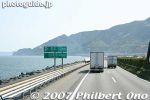
Near Nihondaira is Yui, a scenic point on the coast accessible by car.
|
|
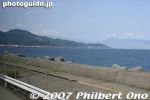
Yui with a view of Mt. Fuji.
|
|
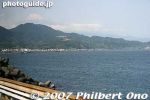
Mt. Fuji as seen from Yui.
|
|

Yui is so scenic that Hiroshige made a ukiyoe print of it in his Tokaido series.
|
|
|
|
|
|
|